#androgyno pride
Photo
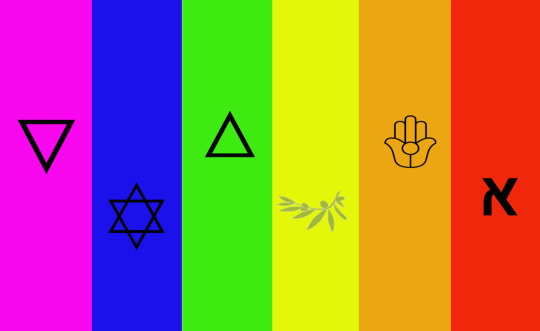
My first go. For sure not a final draft. A flag for Jewish gender diversity. Each color stands for one of the 6 genders listed in the Talmud. A. The Aleph ( א) stands for Androgynos (androgynous). It also stands for Adamah which means earth, and comes from the word dam which means blood (red). It is the first letter in the name adam which means earthling. Adam according to the talmud had both sexes and was an androgynos. Aleph is also the first letter of the alphabet so I put it on the far right where Hebrew begins B. The Hamsa upright is for protection (other way around is for abundance) and it is for Aylonit, or feminine person that takes on masculine characteristics. It is also a symbol which connects all middle eastern and north African peoples C. The olive branch is for the Saris or masculine individual who takes on feminine characteristics, in the torah it is said that a saris is not "a dry tree" so I chose here to show a branch fruitful with peace and abundance. D. the upright triangle is for Zachar meaning masculine, it comes from the word zachor meaning memory or name (like on a family tree) so it is green to denote a tree E. The purple triangle is for Nekivah or feminine but it is also reminiscent of the Holocaust (pink triangle which LGBT people were forced to wear) a trauma all Jewish people share with all LGBT people. By shading it purple I reclaim it as a bridge color between man and woman, Jew and gentile, blue, and red F. The star of David is for Tumtum or for one who is neither masculine nor feminine. It is a combination of both triangles. The talmud tells us that Sarah and Abraham were born Tumtums and it is their line with which all Jewish people trace themselves according to legend.
#jewish#gender diversity talmud androgynos tumtum saris adam adamah pride LGBT LGBTQ Aylonit#gender#diversity#aylonit#androgynos#saris#tumtum#pride#pride month#talmud#lgbt#lgbtq#flag
72 notes
·
View notes
Note
Also if you're still doing flag requests an InterNon flag would also be awesome!! deviantart[.]com/softglitch/art/Intersex-and-Non-binary-InterNon-Flag-919334588
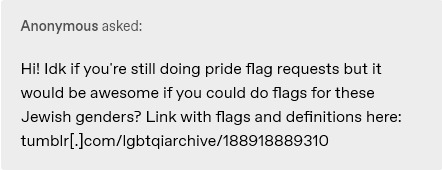
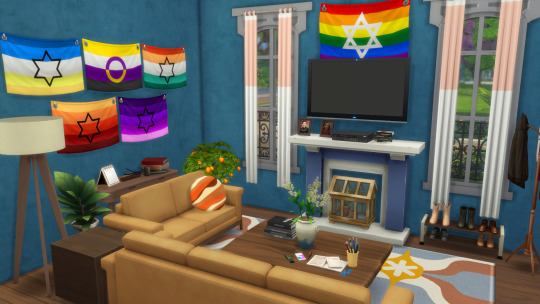
We meet again Anon! Finished your requests, you can find them Here:
[SFS] | [MF]
[Original flags post]
I also added some flags I did as personal recolours, and some my partner wanted, as I've been sitting on them for a while sdfjkldfskjl
Also if the otherkin anon sees this, I added a couple nonhuman/alterhuman flags to the mix as well! You can find the newly added flags below.
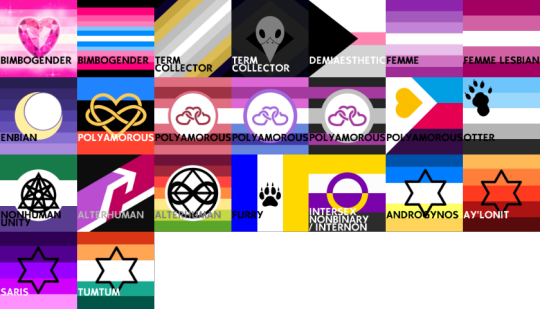
Arin wanted a bimbo-gendered flag so. Who am I to tell him no. The rest that aren't recent requests are the ones I've had for a while. Also I know Furries aren't alterhuman/otherkin etc but I saw it while looking and threw it in there.
[Plaintext: Bimbogender x2, Term Collector x2, Demiaesthetic, Femme, Femme Lesbian, Enbian [alt flag] Polyamorous x5!, Otter, Nonhuman Unity, Alterhuman x2, Furry, InterNon, Androgynos, Ay'lonit, Saris, Tumtum]
#ts4#the sims 4#sims 4#ts4 pride#my cc#faceless#ask#pride flag rqs#InterNon#Androgynos#Aylonit#Ay'lonit#Saris#Tumtum#bimbogender#term collector#ravencollector#demiaesthetic#femme#enbian#polyamorous#otter#nonhuman#alterhuman#I got very distracted helping my cousin do a puzzle earlier or I would'be uploaded this sooner! Apologies there pardner#I forgot how much I love doing little rooms. this one isn't complex but it was fun!!#simple and cozy#I've not seen a lot of jewish gender flags also so this was fun to find more!!#I've only ever seen one for ay'lonit I think#anyway ily anon goodnight!!
14 notes
·
View notes
Text
@gehe-lihiyot-androgynos-varda

[id: A combination of the Gilbert Baker pride flag and the intersex inclusive progress flag. End id.]
10 notes
·
View notes
Text
Unusual Dionysus devotionals:
Basket weaving - baskets are sacred to Dionysus, hence the epithet ‘cittophorus’ meaning basket-bearer.
Do drag/cross dressing - one of his epithets was ‘pseudanor’ meaning ‘false man’, which you could interpret as being related to cross dressing.
Eat meat - another of Dionysus’ epithets was ‘omadios’ or flesh eater, alluding to human sacrifice. I wouldn’t try cannibalism though. If you’re vegan or vegetarian, try a meat substitute like a beyond burger or tofu.
Make a thyrsus with foraged objects - find a pinecone, a large stick (or fennel stalk if possible) and some ribbon. Carve the bark off the stick and sand it back. Glue the pinecone to the top and wind colourful ribbon around it in Dionysus’ colours (purple, gold red, green etc).
Go deer hunting - make sure you or whoever is shooting is a brilliant shot, as you don’t want the animal to suffer. Go through the process of butchering the animal, eating the meat and tanning the hide to get close and comfortable with the cycle of life and death, which Dionysus is a big part of. Wear the deerskin when you go into altered states. I’ve never gone hunting, but my neighbour is a brilliant shot and shoots wallabies when the local population becomes to big, because otherwise the wallabies starve to death with not enough food in the winter. A quick, painless death is kinder and the meat isn’t wasted (yes, you can eat wallaby), and we don’t end up with overpopulation. PLEASE DO NOT HUNT BIG GAME. Seriously. Safari hunting is unnecessary and targets endangered species for the purpose of having a trophy. I know Dionysus wore a leopard skin, but stick to fake leopard fur. If you’re vegan or vegetarian, there are lots of faux furs you can use instead.
Save the bees: honey is a favourite offering to Dionysus and it was said to drip down his thyrsus. By planting bee attracting flowers and not using potentially harmful pesticides, you can help your local bee population. You can also set up a ‘bee hotel’. Purchase local honey if you can! My dad is a beekeeper and he takes so much pride in keeping his bees safe and healthy, but lately everyone’s bees have been dying. It’s really distressing in the beekeeping community, and likely due to a mix of pesticides and climate change, where flowers aren’t blooming due to the weather.
Attend a pride parade - dress as a satyr or maenad and attend pride to celebrate the queer aspect of Dionysus. People will love your costume - I promise. For a satyr, little horns and deer makeup are cool. For a maenad, wear ivy in your hair and loose white clothing. People go to pride in all sorts of clothes so you won’t stick out.
Visit the graveyard where your relatives are buried, or a local graveyard if you don’t have relatives buried near where you live - Dionysus is associated a lot with the dead, and one part of Anthestria was pouring libations on the graves of the deceased. DO NOT TOUCH RANDOM GRAVES. A lot of the time it’s disrespectful, especially in certain cultures. As I don’t have relatives buried in my state, I visit the local graveyard and just sit there, listening to the sea and feeling at peace. I also read about the people buried there and pray that they are at peace.
Go thrift shopping for things he might like - take Dionysus thrift shopping with you and buy things you are drawn to for his altar. I got these at the thrift store:

18+
Being a switch - one of Dionysus’ epithets is ‘androgynos’ meaning to take on the position of both female (submissive) and male (dominant)
Throw a modern day bacchanal - invite over a group of like minded people and go absolutely feral. Dance and sing and get drunk and get into a frenzy.
164 notes
·
View notes
Text
May 2020 bring you closer to self-love, your chosen family, your transition goals, gender euphoria, and the best possible version of yourself. Thank you for making it this far.
#trans women#transmasculine#trans pride#trans#transgender#genderflux#genderfluid#genderqueer#demigender#demiboy#demigirl#tumtum#androgynos#androgyne#saris#transfeminine#mod e
513 notes
·
View notes
Text
Gyne-curious Pride Flag
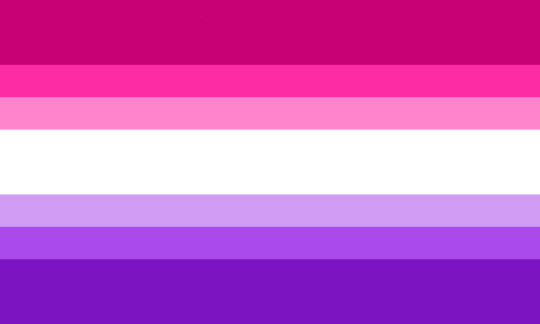
Gyne-curiosity: being primarily nofemaric (not attracted to women) but showing interest in women for any reason; wishing or considering to experiment sexual/sensual or romantic/affectional/platonic relations with women but you usually don’t feel attracted to them.
The individual may be anattractional, mascic (attracted to men) &/or enboric (attraction to non-binary people).
Also known as gyno-curious, gyneco-curious, gine-curious, gineco-curious and gino-curious.
- AP
#matri-curious#androgyne-curious#ambi-curious#gynecurious#pride flag#gyne#curious#fin-curious#fem-curious#femi-curious#femini-curious#flag#curiosa#androgyno-curious#gynandro-curious#ginandro-curious#bi curious#fe-curious#femo-curious#femino-curious#effemino-curious#efemino-curious#afemino#effemi#efemi#efemo#efemini#effemo#curiosity#afemini
44 notes
·
View notes
Text

imaginarium : a place devoted to the imagination, largely devoted to simulating and cultivating the imagination, towards scientific, artistic, commercial, recreational and/or spiritual ends.
Hello, bonjour and pusu’l, lovelies! My name’s Arcana, I’m twenty years old, a Canadian, a Solar Cancererian, a Lunar Sagittarian and a Rising Libra, according to the Western Zodiac, and a Dragon according to the Chinese Zodiac, Genderfluid, Multigender, Transgender, Non-Binary, Intersex, Queer, Autigender, Pearlian, Two Spirit, Androgynos, Draoidhe, DemiOmniBiromantic/DemiOmniBisexual, Autistic and otherwise neurodivergent, ENFP, Ravenpuff, Thunderbird, Otherkin, Therian, an Animist, a Pagan and I’m intrigued in the occult and witchcraft and I am additionally a white passing mixed triracial multi-indigenous person of color or more specifically, of Mi’kmaw, Wyandot, Wolastoqiyik, Métis and Sephardi Jewish heritage! I like cuddling and playing with cats and dogs and animals, eating pizza, taking pictures, music, reading, writing, gushing about friends and helping others. So with that said, I’m here to present you guys my new rpc / rph / aesthetic / inspiration / resource / personal / edit blog ! It’s for my own use but it can also be for your use ( provided you don’t take any of my original content off of this blog without my express permission ), the rpc and anyone else who wishes to use it, too! It features musings, codes, psd’s, psa’s, memes and a LOT more sprinkled with the occasional original content from me.
WHAT I DO:
a discord server affliated with this blog.
faceclaim help. ( poc, lgbtqia2+ and underused faceclaims included! )
alternate faceclaim suggestions ( send me a faceclaim that you don’t want to use and I’ll make a list of alternates. )
fancasts ( send me a character and i’ll make a post of potential faceclaims. )
name help.
label help.
plot help.
admin advice.
url help.
muse help. ( i.e names, concepts, character creation, worldbuilding, lore, etc. )
guides &&. tutorials.
general advice and being here to talk to.
rp advice.
opinions. ( depending on what it is. )
memes.
musings.
muse inspo.
base icon batches ( uncommon, but will open on occasion. )
psd recommendations.
shoutouts.
masterlists.
promo’s. ( provided you submit it to me as a photo. )
psa’s.
unpopular opinions.
character metas. ( occasionally, depending on the muse and on the fandom. )
positivity. ( muses — be they canon or original, fandom aligned or otherwise, and muns. )
venting. ( nothing hateful or discriminatory ! )
rants. ( nothing hateful or discriminatory ! )
first look reviews. ( on occasion. )
critiques. ( on occasion. )
in-depth blog reviews. ( on occasion. )
muse archetype aesthetic edits / moodboards. ( i.e the artist, the femme fatale, etc. )
dynamic / bond / family / friendship / squad / ship edits / moodboards ( poc, interracial and lgbtqia2+, polyamorous, m/m / mlm, f/f / wlw and nblnb included! )
faceless muse edits. ( muses of color and ships included! )
character emotional traits.
multiple genres, time periods and settings. ( i.e: historical, antiquity, medieval, vintage, modern, supernatural, fantasy, apocalypse, action, horror, science fiction, etc. )
aesthetics. ( i.e dark academia, solarpunk, retro, goth, lovecore, etc. )
theme recommendations.
template recommendations.
family templates ( occasional. )
fandom lists ( eventually. )
masculine, feminine and nonbinary.
cultural awareness.
locations ( including but not limited to interiors, exteriors, homes, and all the continents. ).
scenery.
nature.
animals.
mythology.
weddings.
religion ( specifically for muses from certain religions i.e jewish and muslim muses, etc. )
disabled and neurodivergent muse representation and resources.
resources and representation for the lgbtqia2+ / mogai community and its muses, i.e lesbian muses, gay muses, bi muses, trans* ( including nonbinary, genderfluid, genderless and other non-cisgender ) muses, queer muses, intersex muses, aromantic / asexual muses and two spirited muses, among other muses that are considered queer.
resources and representation for all muses of color, including black muses, indigenous / native muses, latinx muses, asian muses ( all asians, not just east asians ! ), pasifika muses, jewish muses, etc., that overpower than that of white muses, there are still resources for white muses, though muses of color will always be a priority on this blog.
resources for portraying pregnant muses ( will be tagged! ).
resources for portraying muses who practice witchcraft.
resources for portraying muses who are sex workers.
resources for muses of all ages, including children, adolescents, adults and elders.
resources for animated muses.
resources for nonhuman muses.
cuisine.
makeup ( for muses of all genders ! ).
tattoos.
nsfw. ( will be tagged ! )
pride flags.
texts.
userboxes.
seasons.
colors.
zodiac.
typography.
concepts.
plots.
imagine your otp/ot3/etc.
“make me choose” events.
confessions.
wardrobe.
physique ( friendly to all skin tones, body types, shapes and sizes! ).
wishlist.
faves.
crack.
shitposts.
mun stuff.
music playlists ( including my own spotify playlists ).
aesthetics and edits of my own muses.
resources and character tags for my muses.
stimboards.
occasionally post some of my fanfiction / drabble works.
occasional drabble / fanfic requests.
occasionally post some of my music works.
possibly post specific music edits when i figure out how to do so.
more to be added when i think of something.
WHAT I WILL NOT DO:
callout posts.
drama posts.
get involved in discourse.
flame other people.
bash on characters, fandoms and/or ships.
post recent spoilers of a series without tagging it.
tolerate bigoted, homophobic, lesbophobic, biphobic, omniphobic, panphobic, aphobic, arophobic, transphobic, enbyphobic, queerphobic, racist, colorist, sexist, exorsexist, intersexist, heterosexist, anti-polyamory, anti-mogai, anti-neopronouns, anti-nounself pronouns, anti-emojiself pronouns, anti-self diagnosis or mental health gatekeeper, victim blaming, gender/orientation/mental health gatekeeping, anti-otherkin, anti-feminist, ageist, speciesist, ableist, fatphobic, anti-black, anti-native, islamophobic, antisemitic, antiromani, xenophobic, exclusionist, transmeds/truscum, terfs/swerfs, radfems, heightist, sizeist, discrimination on cultures and subcultures, discrimination on religion or lack thereof, mysogynist/misandrist, white supremacist or any kind of supremacist honestly, nationalist, linguistic discrimination, or otherwise hateful, discriminatory, derogatory, vulgar and just overall dumb language, speech, behaviors and attitudes.
gif requests.
gif hunts.
manips.
textures.
crackship edit requests ( unless stated otherwise. )
edited icon batches ( unless if i’m releasing my own that i no longer use. )
theme / page / code making.
psd making.
more to be added if i think of something.

So, with that said, PLEASE like and/or reblog this if you’re interested in using it or at the very least spread the word! I really want to try and help people and have fun with you guys, but I can’t do that if this doesn’t get any notes. You can find out more information by reading my F.A.QHERE! Thank you so much for reading, I hope you all have a wonderful morning/day/evening/night! Yours truly, with all of my love, Arcana.
39 notes
·
View notes
Text
pride month fact of the day ⊹ 21/30 ⊹ rabbinic jewish texts discuss six sex/gender categories: zachar, nekevah, androgynos, tumtum, ay’lonit, and saris. read the meanings below the cut!
zachar (זָכָר): this term is derived from the word for memory and refers to the belief that the man carried the name and identity of the family. it is usually translated as "male" in english.
nekevah (נְקֵבָה): this term is derived from the word for a crevice and probably refers to a vaginal opening. it is usually translated as "female" in english.
androgynos (אנדרוגינוס): a person who has both "male" and "female" physical sexual characteristics // 149 references in mishna and talmud (1st – 8th centuries ce); 350 in classical midrash and jewish law codes (2nd – 16th centuries ce).
tumtum (טומטום): a person whose sexual characteristics are indeterminate or obscured // 181 references in mishna and talmud; 335 in classical midrash and jewish law codes.
ay’lonit (איילונית): a female who does not develop at puberty and is infertile // 80 references in mishna and talmud; 40 in classical midrash and jewish law codes.
saris (סָרִיס): a male who does not develop at puberty and/or subsequently has their sexual organs removed. (a saris can be “naturally” a saris (saris hamah), or become one through human intervention (saris adam)) // 156 references in mishna and talmud; 379 in classical midrash and jewish law codes.
#note!!! i am not jewsh my friend is and the first bit came from him and the rest came from wikipedia#please let me know if any of this is wrong or if i should take this down as i am not jewish!#queer pride#mcpmfotd#pmfotd#queer#pride#pride month#shareyourpride#lgbtq+#lgbtq#lesbian#gay#bi#bisexual#biromantic#trans#transgender#nb#nonbinary#pan#pansexual#panromantic#homosexual#homoromantic#ace#asexual#aro#aromantic#aroace
2 notes
·
View notes
Text
Nonbinary Genders Throughout History
I started compiling these with the intention of posting them on trans visibility day as a congrats to @neurodivergent-crow getting their top surgery consultation (woot!), but I kept finding more and more and more third gender figures and it developed into this ever-growing monster of a list of genders to research about... and next thing I know we’re entering Pride month.
I've already found 24 extinct genders and 48 modern ones, so I figured I could start with the extinct ones I’ve already researched and post more instalments as I go so people don’t have to scroll for half an hour to get to the end of this post. ;P
~~~~~~~~~~~~~~~~~~~~~~~~~~~~~~~~~~~~~~~~~~~~~~~~~~~~~~
Ay’lonit [איילונית] (Ancient Israel)
A person who is identified as “woman” at birth but develops “man” characteristics at puberty and is infertile.
There are 80 references to this gender in the Mishna and Talmud and 40 in the classical midrash and Jewish law codes.
-----------------------
Androgynos [אנדרוגינוס] (Ancient Israel, from at least 1st century CE to 16th century CE)
A person who has both “male” and “female” sexual characteristics.
There are 149 references to the gender in the Mishna and Talmud and a whopping 350 mentions in classical midrash and Jewish law codes.
-----------------------
Assinnu (Assyria, Mesopotamia)
An ambiguous gender often represented as being a passive man, but which also at one point was "listed among a group of female cultic attendants".
In Mesopotamia, the man was supposed to be sexually active while the woman took on the passive role. Because of the assinnu's passivity, they were categorized as a third gender figure.
-----------------------
Çengi (Ottoman Empire, now Turkey)
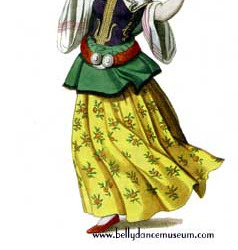
According to Şehvar Beşiroğlu they were “dancers who are non-moslems or [Rromani]”.
From what I understand the term has now evolved to be the feminine form of the noun “dancer” in Turkish, but it was originally considered to be a gender separate from man or woman, which is why I put it in this extinct gender list.
-----------------------
Gala (Sumer, Mesopotamia, 3000 BCE)

^ Cuneiform tablet of Old Babylonian Sumerian proverbs mentioning the gala
A person who is identified as “man” at birth who is a "chanter of laments".
Simply working as a professional lamenter categorized them as feminine because laments were typically performed by women (not unlike how men who practised seiðr magic were regarded in Norse culture).
During the Old Babylonian period, the role of the gala expanded and became a synonym of kalǔ, becoming a singer who dealt with music-related areas of the worship of Ishtar.
-----------------------
Girseqû (Mesopotamia)
A person who is identified as “man” at birth who is a childless figure within palace administration.
-----------------------
Kalǔ (Akkad, Mesopotamia)

^ According to the inscription, the beardless person is Ibni-Ištar, kalû of Ištar-of-Uruk.
A person who is identified as “man” at birth who is a "chanter of laments".
Simply working as a professional lamenter categorized them as feminine because laments were typically performed by women (not unlike how men who practised seiðr magic were regarded in Norse culture).
During the Old Babylonian period, the role of the gala expanded and became a synonym of kalǔ, becoming a singer who dealt with music-related areas of the worship of Ishtar.
The kalǔ were institutionalized into religious practice and ritual in order to maintain strong social distinctions between men, women, and a third gender comprised of non-conformative males.
-----------------------
Koekchuch (Itelmens, Siberia, mid 18th - early 19th century)
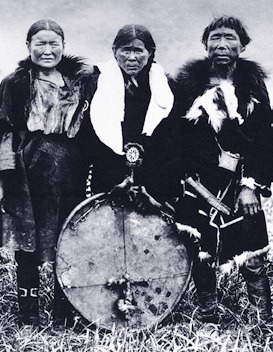
Individuals assigned to be men at birth but “who wear women's clothes, do women's work*, and have nothing to do with men, in whose company they feel shy and not at their ease”.
It was not uncommon for men to have up to three wives as well as one or more koekchuch (some men reportedly bypassing having any concubines altogether and preferring to have one or more koekchuch instead).
Note 1: Just as a heads up, the link for this gender has transcriptions of material from the 1750s, and as such features some racist, homophobic, and transphobic language.
It’s nothing overly colourful, mostly just the writer having the judgy kind of jerkward attitude you’d expect from a 1700s Christian ethnocentric academic, but I figured I’d give y’all a heads up just the same. :)
Note 2: The book this info comes from, Pacific Homosexualities by Stephen O. Murray, is a treasure trove for anyone interested in the subject, as it features tons of primary sources you’d be hard-pressed to find access to if it’s not your field in academia.
It costs around $40 on Canadian Amazon.
---------------------
Kurgarrǔ (Sumer, Mesopotamia)
Kurgarrǔ were people assigned as men at birth who took part of the cultic performance for Ishtar and presented themselves as militant and masculine.
The kurgarrǔ were considered a third gender because of their involvement in the worship rites for Ishtar, a role that was considered to be ambiguously gendered because Ishtar was an ambiguously gendered deity.
-----------------------
Lύ-sag/Ša rēši (Mesopotamia)
A palace attendant typically in charge of women’s quarters within a palace.
The term Lύ-sag was interchangeable with Ša rēši.
It’s implied in contemporary accounts of the Middle and Neo-Assyrian periods that they were eunuchs, though there are no such mentions in other periods in the culture’s history.
-----------------------
Mukhannath [مخنثون] (Umayyad and Abbasid Caliphates, Middle East, 4th-7th century CE)
A term used in Classical Arabic to refer to men who were perceived as effeminate.
During the Rashidun era and the first half of the Umayyad era, they were strongly associated with music and entertainment.
During the Abbasid caliphate, the word itself was used as a descriptor for men employed as dancers, musicians, or comedians.
In later eras, the term mukhannath was associated with the receptive partner in gay sexual practices, an association that has persisted into the modern day.
-----------------------
Paṇḍaka (Buddhist, 2nd century BCE)
Mentioned in the Vinaya as one of the 4 genders, it is a somewhat catch-all term for anyone who does not conform to the other 3 genders (for the other Buddhist third gender mentioned in Buddhist scripture, scroll down to “Ubhatobyanjanaka”).
“As the Vinaya tradition developed, the term paṇḍaka came to refer to a broad third sex category which encompassed intersex, male and female bodied people with physical and/or behavioural attributes that were considered inconsistent with the sexual ideal of man and woman.”
-----------------------
Pilpilû (Mesopotamia)
A member of the Ishtar cult** with feminine traits.
** When talking about ancient theology, “cult” doesn’t have quite the same meaning as it does in everyday language. It just means they worshipped Ishtar.
-----------------------
Sadhin (Gaddhi people, in the foothills of the Himalayas)
People identified as women at birth who renounce marriage and dress and work as men, but retain female names and pronouns.
-----------------------
Sanskrit Third Gender
The Mahābhāṣya, a book on Sanskrit grammar from circa 200 BCE, claims that the 3 linguistic genders of Sanskrit are based on “the three natural genders”.
The Ramayana and the Mahabharata (the two Sanskrit great epic poems) also indicate the existence of a third gender in ancient Indic society.
-----------------------
Saris [סריס:] (Ancient Israel)
A person who is identified as a “man” at birth but develops “woman” characteristics at puberty and/or is lacking a penis.
A saris can be “naturally” a saris (saris hamah), or become one through human intervention (saris adam).
There are 156 references to this gender in mishna and the Talmud and 379 in classical midrash and Jewish law codes.
-----------------------
Sḫt (Egypt, 2000–1800 BCE) [pronounced “sekhet”]
“Someone who is neither a man nor a woman.”
Because the gender is known from only a few pottery shards, it’s not entirely clear whether the ancient Egyptians were referring to man and woman in the sense of sex or gender roles or both.
Note: Since the bulk of early archaeology was dominated by cishet white men who believed only two genders exist, the term has historically been generally translated as “eunuch”.
However, there’s little to no indication that sḫt were all biologically male (let alone castrated ones at that), and the eunuch interpretation of the word has begun to be questioned by gender study historians.
-----------------------
Tamil Third Gender (x2!)
The Tolkappiyam, the oldest known book of Tamil grammar, refers to intersex folk as a third "neuter" gender, as well as mentioning a feminine category of unmasculine males.
-----------------------
Tīru (Mesopotamia)
Not much is known about this gender.
Historians believe it was likely a childless castrate who had a part of palace bureaucracy (I don’t know if this is like the case of the sḫt and cishet dudes just have a propensity to assume “third gender person assigned male at birth = eunuch” or if there’s evidence to back this up).
-----------------------
Tumtum [טומטום] (Ancient Israel)
A person whose sexual characteristics are indeterminate or obscured.
According to Maimonides' Mishneh Torah, Mada, Avoda Zara, 12, 4 Tumtum is not a separate gender exactly, but rather a state of doubt about what gender a person is (kind of like a Schrödinger’s gender?).
I added it to the list because I thought that, like myself, some folks might find it interesting (and it is gender-related...). :)
-----------------------
Ubhatovyanjañaka (Buddhist, 2nd century BCE)
Mentioned in the Vinaya as one of the 4 genders, it is the gender of people with a dual sexual nature (for the other Buddhist third gender mentioned in Buddhist scripture, scroll up to “Paṇḍaka”).
~~~~~~~~~~~~~~~~~~~~~~~~~~~~~~~~~~~~~~~~~~~
P.S. I tried to not use transphobic language, but I’m still learning, so if anyone sees any error please let me know so I can fix it and learn from my mistake! :)
#pride month#woot woot#nonbinary#third gender#transgender#lgbt+ positivity#lgbt representation#lgbt+ history#transgender history#non-binary#happy pride 🌈#read your bible#torah#babylonia
33 notes
·
View notes
Text
Tumtum and Androgynos
Tumtum and Androgynos as well as the other terms in the "culture exclusive gender” tag are genders that are specific to certain cultures and should not be used by people not of that culture. If you're not sure you're able to use this, feel free to send an ask on my ask blog [Link], I have followers that could help you out!
(Copied from this post [Link])
These are both genders from Jewish culture, so they’ll both be in this post. Tumtum (first one) is where a person’s gender is hidden or private, and is closest to agender. Androgynos (second one) is where a person is intersex or otherwise has qualities of a woman and a man, and thus would be closest to bigender. Both genders are assigned to children if they are born as intersex.
Unfortunately, the most that you would see of tumtum and androgynos is discussions of how to deal with the child’s genitals (as in, whether or not to perform surgery; tumtum is usually assigned to intersex conditions where the genitals end up covered by skin, and androgynos is assigned to intersex conditions where they are a mix of the usual two). Either that, or these two genders are treated as mere “what if” genders for certain laws (for instance, if a law states different treatment for women and men, how would it apply to someone who is both or neither? That sort of thing).
[T]here is definitely a movement IRL to bring more attention to these two genders. We encourage any nonbinary Jewish people who are reading this to consider if tumtum or androgynos may be fitting for them. Or at least reblogging this so that the information may spread! For helpful links, again, there isn’t too much other that repeats of what I’ve mentioned here, but this is a wonderful autobiographical account of a tumtum rabbi and their dealings in promoting these two genders as viable Jewish nonbinary genders!
Tumtum:

Full size [Here]
Androgynos:
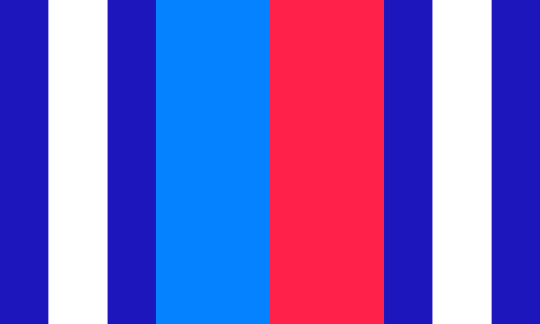
Full size [Here]
[Image: Two flags, both are spilt into three vertical bar sections. The middle of the first one is completely gray, and the middle of the other is further split by two more vertical bars, one reddish-pink on the right side of the centre, the other light blue and on the left side. On either side of these central bars, the two outer sections are further divided into three vertical bars. Those bars are blue, white, and blue.]
Designed by: Anonymous
Color meanings: For the symbolism of the flags, we put the white and blue bars on both to represent a connection to Judaism. In particular, blue is considered a divine color, associated with the sky and G-d. Meanwhile white has a general symbolism of purity, as it does in many other cultures. The grey for tumtum is because I’ve found grey has an association with agender, which as I mentioned is probably the closest English equivalent to tumtum. Not to mention, grey can be seen as some obscure/not specific/hiding, similar to the idea of tumtum gender. For the androgynos flag, the blue and red bars represent man and woman, thus how androgynos is seen as a mix of the two.
Full pride gallery HERE! FAQ and “dictionary” of genders, orientations, and other related terms HERE. Send any questions to Ask-Pride-Color-Schemes!
24 notes
·
View notes